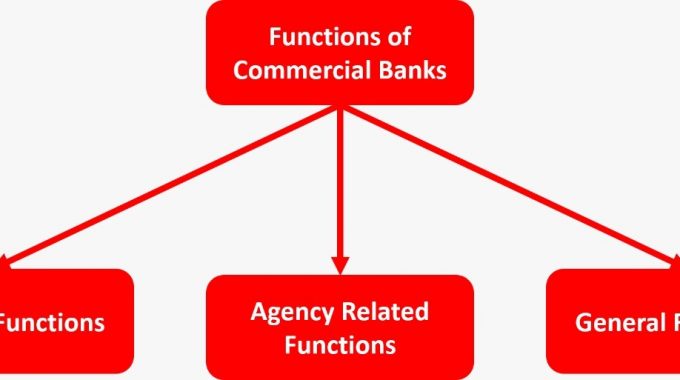Read this article to learn about the various functions of commercial banks…
Commercial banks offer many tasks and services to its customers in today’s era. In addition to receiving deposits and lending money, the bank edits its work. All the major function of the commercial bank can be divided into three forms:
These three points are very or most important function of a commercial bank:
- Primary or Modern Functions.
- Agency-related Functions.
- General or Other Functions.
1. Primary Functions of Commercial Banks-

The primary function of a commercial bank can be divided into two parts like, (i) Depositing money, (ii) Granting loans.
(A) Depositing Money:
The banks receive deposits in various accounts by encouraging the public to save. It gives interest on the money and is liable to return them when demanded by the customers. The bank receives deposits from its customers in the following accounts.
(i) Current Deposits:
The amount deposited in this account can deposit and withdraw as much as you like in the day. Merchants and such entities have to deposit and withdraw money several times a day. For this, the current account is opened.
The bank is not paid interest on this account, but the bank takes interest from the general interest. This account is very useful for traders because they require transactions in order to pay for several times a day.
(ii) Fixed Deposits:
The fixed account is the one who takes the bank for a certain period. This account is called a permanent account related to a deposit. After opening these accounts, the bank gives the fixed deposit receipt and after the expiry of the receipt, the bank also withdraws the amounts and take the receipt.
Interest rates on these accounts are high.
(iii) Saving Account:
This account is opened by middle and lower-middle-class people in which they deposit their small savings for the future. There are certain restrictions placed on this account, such as- The depositor can withdraw a fixed amount from this account only once or twice a week.
In order to collect the amount, the form of withdrawal and cheque is given to the depositor in this account.
(B) Granting Loans:
The secondary important function of commercial banks is to provide loans. In fact, depositing or lending is the two pillars on which the structure of the banks is present. Loans are given for productive work through various measures:-
(i) Cash Credit:
Under this, the loanee is given the right to withdraw a certain amount on the basis of sure security. Within this limit, the loanee comes out and deposits as per the requirement.
In this stage, the bank only gives interest on the amount actually withdrawn.
(ii) Overdraft:
Customers with current deposits in the bank get permission to withdraw more than their deposits in accordance with an agreement form the bank.
The amount withdrawn is called an overdraft. This facility is available to trusted customers only.
(iii ) Investment in Government Securities:
Buying government securities by banks is also a way of lending to the government. Many banks like to buy government securities because it is considered to be the safest lending.
(iv) Credit Creation:
Nowadays, one main function of banks is to build goodwill. Banks make credit by lending more than their lending deposits.
2. Agency-Related Functions of Commercial Banks-

It includes those works which are done by the bank on behalf of any customers and takes necessary commissions for these works, which is an important instrument of its income. Some such important things are as follows:-
(i) Collection of payment of Credit Instruments:
The bank deducts its commission by collecting the money received from the exchange bill, cheques, or pledge letters received from its customers and deposits the balance in their account.
(ii) Payment on Behalf of Customers:
Banks also complete payment orders of all types of customers like- Installments of loans on their behalfs, interest, donation, Insurance Installment, pay taxes, etc.
For this work, the bank takes ordinary commissions from the customers.
(iii) Collection of Payment:
Banks also collect dividends and interest and commissions from their clients. This work is done by bank on its commission basis.
(iv) Sale and Purchase of Securities:
Thus, the banks are well-acquainted with the market situation, they continue to provide proper consultation with their customers for the purchase and sales of securities and sell or purchase them as per their order.
(v) Functions of Pertaining to Trust etc.:
Bank serves as trust, attorney, executives, and advisors for the customers.
(vi) Remittance of Money:
According to the orders of customers, the bank arranges to send money from one place to another place quickly.
3. General Functions of Commercial Banks-

Apart from the above-mentioned services, a commercial bank offers many other facilities to its customers and generals, such as-
(i) Custody of Valuables:
Banks keep lockers facilities for their customer’s jewelry, precious things, precious papers, etc to keep them securely.
(ii) Facility of Letter of Credit:
Banks issue certificates of credit and passports to their customers.
(iii) Helpful in Transportation of Goods:
Large merchants send the goods to their customers and send their bills to the bank. By depositing the money in the buyer’s bank, they get rid of the bills and take the goods.
(iv) Collection of Business Information and Data:
Modern banks collect and publish a variety of data and information related to industry and trade and commerce, and provide to their customers on its demand.
(v) Underwriting of Loans:
Commercial banks also underwrite its securities, that is, the banks take responsibility for selling a part or other securities bought by their customers. In lieu of this work, they take the underwriting charges and commission from the customers.
Other Related Questions-
1. What are the functions of Commercial Bank?
Ans: Commercial bank is an institution by which the customers can easily deposit and receive the bulk or short amount of money. It can be classified their functions into three several categories,
- Primary functions.
- Agency-Functions.
- General Functions.
2. Explain or discuss the various functions of commercial banks?
Ans: The answer to this question is the same as the first question.
